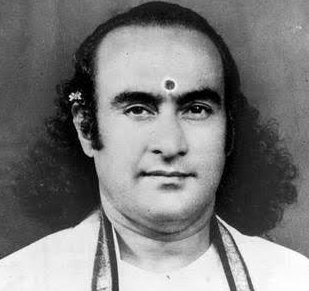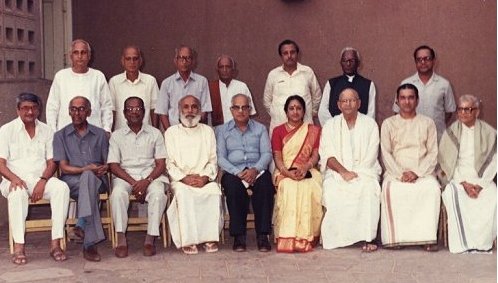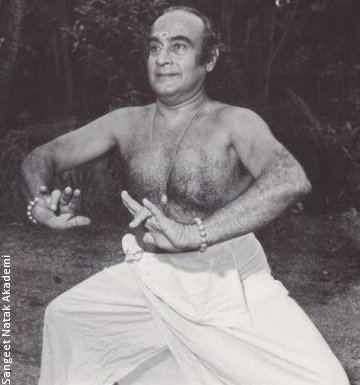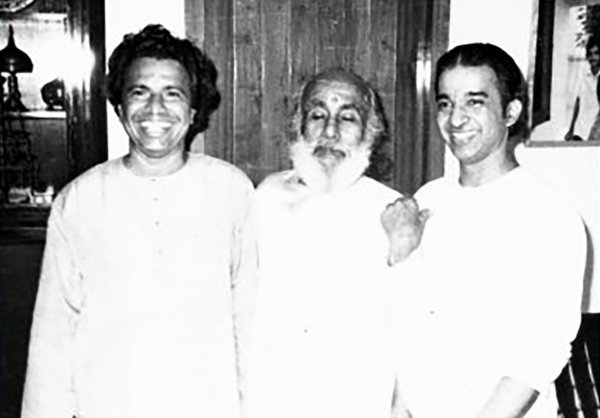 |
  |
 |
  |
Guru Gopinath-An epic personality - VP Dhananjayan e-mail: bkalanjali@gmail.com Photos courtesy: VP Dhananjayan August 22, 2021 (With inputs from Guruji's devoted disciple Tapati Chowdurie) In my childhood, I grew up watching Guru Gopinath's Navarasa pictures in Mathrubhumi weekly and every now and then got inspired to imitate his exquisite facial expressions, least expecting that I would become a performing artiste at that time. Providence brought me to Kalakshetra in 1953, and ever since, I started watching him at close quarters performing at various venues in Madras whenever there were cultural delegations from foreign countries, where Kalakshetra was also a participant. I was really excited watching him at close quarters and tried to imbibe his histrionic excellence. My Kathakali Guru Chandu Panikkar was a great admirer of Guru Gopinath and used to comment that "the god given face of this man surpasses divinity of god himself." Listening to such comments from a legendary Kathakali Asan himself, we children took to heart Asan Gopinath as our 'manaseeka guru'.  Guru Gopinath I had never thought or dreamt to be so close to a great personality like him those days, and as my luck would have it, the day dawned in my life to be performing in front of him in his own Kalari in Chennai (then Madras), Natana Niketan, where he along with 4 other great panelists interviewed candidates for the Indian government's cultural scholarship in 1959. I was in the seventh heaven praising my destiny - it was a dream come true. Kathakali Asan Tekkinkattu Raamunni Nair asked me to perform the padam "Sowryaguna needhi jaladhei," Bhima's role from Kalyaanasaugandhikam Kathakali Aattakatha. On completing the interview performance Raamunni Nair Asan seeing my performance, exclaimed that I must be the sishya of Guru Chandu Panikkar. Guru Gopinath stood up and openly declared unaware of the other panelists (including a Government Secretary) that "this boy deserves the scholarship". Everyone around were startled and tried to stop his open declaration. For me, it was a heavenly ordain and a pleasant surprise awaited me when he asked me to wait in his house until interviewing the candidates was over. I remained there for Guruji to come home and bless me with his divine touch. From that day onwards we became close friends...rather, he treated me like that, even though I revered him as my Guru. This incident shows his humaneness, how he appreciated his fellow artistes and recognized them unconditionally. Very magnanimous indeed! Ten years later in1969 history repeated itself, Guruji sitting as the head of the scholarship selection panel and me sitting beside him as one of the panel members. Pat came his comment, "Ten years ago I gave you the same scholarship and now you are sitting with me to do the same job... what a wonderful destiny!" Perumanoor Gopinathan Pillai, more popularly known as Guru Gopinath, was a well known actor-cum-dancer. He is well regarded as the greatest preserver of the naatya tradition of Bhaarat.  Guru Gopinath with the Board Members of the Indian Fine Arts Society when he was awarded the Naatya Shiromani Guru Gopinath was born on June 24,1908 in Kuttanad and died in Ernakulam on 9th October 1987 while enacting the role of Dasaratha in the famous scene of bidding farewell to his son Raama. It was a fitting end to a great son of Bhaarat who spent his life for the cause of the performing arts. In the words of Rabindranath Tagore, "Mr. Gopinath is a real artist and I am sure that there are not many who could rightfully take their place by his side either in Bhaarat or abroad. He brought to my mind glimpses of the great past when dancing was one of the most treasured arts in our country and not as today, a mere device for whetting the jaded appetite of the idle rich. His presence in our midst was a pleasure and now that 'naatya' has again come into vogue amongst us, his style should give us a correct lead for in want of it, we are still groping in the dark." Well versed in the Kaplingadan style of Kathakali, which he imbibed from his family with a two hundred-year-old history in the form, he went to Kerala Kalamandalam for specialized training. With Esther Luella Sherman, popularly known as Ragini Devi, he gave his first performance in Bombay in 1932 of a form he had developed into a contemporary style, which was classical in technique and popular in appeal. Their performance took the world by storm and was the first ever exposition of Kathakali outside Kerala. While struggling for sustenance after training at Kalamandalam, the story goes thus. Guruji went to Mookambika Kshetram to do bhajan or tapas there praying to the deity to show him a way to survive and bring to life his creativity and much cherished dreams. Yes, he strongly believed that Mookambika blessed him in the form of an invitation received from Ragini Devi (a foreigner) conveyed through Vallathol Narayana Menon. After that, his life was a success story, never to look back to his grueling days at Kalamandalam.  Guru Gopinath presenting a Kathakali mudra He is considered one of the epic personalities of Bharatanaatyam (a comprehensive term for the entire Bhaarateeya Naatya traditions) in the 20th century like Uday Shankar. He extended the boundaries of Kathakali by teaching this male dominated 'naatya' form to women too. His choreographic works dealt with subjects apart from stories from Bhaarat's epics and mythology - Sree Yeesunaadha, Sister Nibedita, Chandala Bhiksukhi, Kerala Piravi and the Ramlila of New Delhi are a few examples. During the centenary celebrations of Rabindranath Tagore, he choreographed Natir Puja in which his prime disciple Tapati Chowdurie had taken the lead role. His path breaking form came to be known as Kerala Natanam. Once a palace dancer and principal of the naatya institution of the royal family of Travancore, he founded Natana Niketan in Madras, International Kathakali Centre in New Delhi and Viswa Kala Kendra in Thiruvananthapuram.  K.P.Kunhiraman, Guruji and V.P. Dhananjayan His illustrious demonstration of Navarasa is featured in the major museums of the US, France, Germany and Switzerland. Recipient of numerous accolades and awards, he was given the Sangeet Natak Akademi Award in 1954. The Department of Culture, Government of Kerala started Guru Gopinath Natanagramam in 1994. It is the first dance museum of its kind in Bhaarat. He was a member of the first cultural delegation of independent Bhaarat to the USSR in 1954 and was also invited as a judge of classical dances in the Eighth World Youth Festival held at Helsinki, Finland in 1961. Following the Guru-sishya parampara, his daughter and disciple Vasanti Gopinath Jayaswal has developed Gopinath Kaavyam - a one-and-half-hour solo format of Kerala Natanam. It has guidelines to differentiate 'padams' from 'sabdams'. In Kerala Natanam, each item would follow the other in such a way that there is a pyramidal effect of building up to a heightened sense of aesthetic pleasure. The music will specify the combinations for each item so that justice is done to the versatility of each instrument. Visuals are to be of modest design. The solo format in Kerala Natanam will provide a minor change to the existing costume that will immediately suggest the powerful masculine quality or the soft feminine quality that may be a striking feature of the particular item and ornamentation to be based on ancient Kerala mural paintings. A solo format will follow specifically of a presentation in brevity. Vocalists, wind and stringed instruments are to be on one side and percussion on the other, on raised platforms. Dimmed lights rather than the use of curtains are preferred. Purvarangam will use a good panchavadyam to precede Guru Vandanam by a live vocalist. The first piece would be Jarjara Nritya accompanied by edakka and taalam in triputa/misra chaapu or khanda chaapu. A dancer holds the Indra dwaja (stag pole) made of several mutthukkoda (ornamented umbrella) in a variety of colours. Mudras are to be held only for balancing purposes and movements should be free of hardness. The stag pole is placed into a receptacle in the front corner, which will be there till the end. At the conclusion, the vocalist recites verses from Mantra Pushpam or any such equivalent benediction, while the dancer remains in a namaskara pose. That is to be followed by Taana Lahari, which is a pure nritta piece, to the accompaniment of mainly the veena. Mridangam and taalam are to be the accompaniments in adi, champa, rupaka taalams with no raagams and theermanams. On the other hand, Kathaa Maalika will comprise excerpts from the Puranas with many characters and the artiste himself playing the various roles in both taandava and laasya features using rhythmic and raaga variations. Vocal (more than one if possible, such as a male and a female) is accompanied by selected stringed or wind instruments. It is better not to play too many instruments at the same time unless a grand conclusion is suggested. Antarangam will use abhinaya padam. The item involves the depiction of the various mano-vritti stages of one particular character alone. One vocalist sings. Music is enhanced but not replaced by instruments. The best taala-bheda is to be displayed in taala-abhinaya. The song begins with an abhinaya piece with two to four lines of the saahitya with a catchy rhythm and lyric. This is to be intermingled with kalpana svaras or svaraalankara segments. A shlokam in praise of Lord Rama followed by the hymn of "Raama Raama Jaya Raaja Raam" will be the closing Mangalam piece. This was the epitome of Guruji's creativity and master choreography, not to talk of his monumental Navarasa delineation, Shiva Parvathi Natanam, Geetopadesham etc. His ardent sishya Kodungallur Gopalakrishnan stood by his side throughout and Kusum Gopalakrishnan also played a great role in Guruji's monumental productions at Natana Niketan. Suffice it to conclude that Guru Gopinath along with his equally merited consort Thankamani Kutty inspired a great generation of performing artistes following their legacy and we the Keralites can justifiably be proud of creating and establishing a centre in his memory, which should serve as a beacon light to the generations to come.  Naatyacharya V.P.Dhananjayan is the Founder/President of Bharata Kalanjali, Chennai. Post your comments Please provide your name and email id along with your comment. All appropriate comments posted with name and email id in the blog will also be featured in the site. |